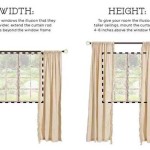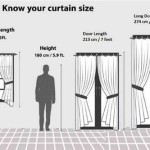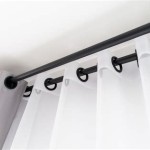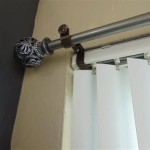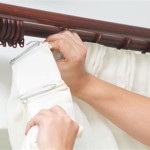Curtains With Pleats and Hooks: A Comprehensive Guide
Curtains with pleats and hooks represent a classic and sophisticated window treatment option. This style of curtain offers a tailored appearance, creating a sense of order and elegance in a variety of interior design schemes. The combination of pleats – manufactured folds that create fullness – and hooks – a reliable suspension method – provides a durable and aesthetically pleasing solution for controlling light, privacy, and temperature within a space.
The longevity of pleated and hooked curtains stems from their inherent functionality and visual appeal. Unlike some other curtain styles that may appear casual or informal, pleats lend a degree of formality, making them suitable for living rooms, dining rooms, bedrooms, and even certain office environments. The hooks, used to attach the curtain to a track or rod, ensure a secure and even distribution of weight, contributing to a well-draped and professionally presented appearance.
Understanding the different types of pleats, the corresponding hook styles, and the appropriate hanging methods is crucial for selecting and installing curtains with pleats and hooks effectively. This guide provides an overview of these key components, empowering the reader to make informed decisions when choosing this type of window treatment.
Understanding Pleat Styles
The term "pleat" refers to a fold in the fabric that is secured to create a specific shape and volume. Different pleat styles offer varying degrees of fullness and visual interest. The most common pleat styles include pinch pleats, pencil pleats, and goblet pleats, each offering a distinct aesthetic.
Pinch pleats, also known as French pleats, are characterized by groups of two or three pleats gathered together at the top of the curtain. This style creates a structured and tailored look, with the fabric cascading down in defined folds. Pinch pleats are often considered a more formal option and are commonly used in traditional or transitional interior designs.
Pencil pleats are created by a tightly gathered heading that resembles a row of pencils lined up. This style is more casual than pinch pleats but still provides a neat and uniform appearance. Pencil pleat curtains can be adjusted to achieve the desired fullness and are suitable for a wide range of fabrics and room styles.
Goblet pleats are distinguished by their rounded, goblet-shaped folds at the top of the curtain. This style is considered highly formal and luxurious, often found in upscale residences and hotels. Goblet pleats require more fabric than other pleat styles and create a dramatic and opulent effect.
Beyond these common styles, other pleating techniques exist, including box pleats, cartridge pleats, and tailored pleats. Each style offers a unique variation in fullness and drape, allowing for customization based on personal preference and design requirements. The choice of pleat style significantly impacts the overall appearance of the curtain and should be carefully considered in relation to the room's décor.
Choosing the Right Hooks
The hooks used to hang pleated curtains play a critical role in ensuring proper drape and functionality. The type of hook required depends on the pleat style and the type of track or rod being used. Several types of curtain hooks exist, each designed for specific purposes.
Pin hooks, also known as drapery hooks, are the most common type of hook used with pleated curtains. These hooks feature a sharp pin that is inserted into the back of the pleat heading, securing the curtain to the hook. Pin hooks are typically adjustable, allowing for fine-tuning of the curtain's height and drape. They are compatible with various track and rod systems, making them a versatile option.
Pinch pleat hooks are specifically designed for pinch pleat curtains. These hooks have multiple prongs that are inserted into the pre-formed pleats, ensuring a secure and even distribution of weight. Pinch pleat hooks are often made of metal and are designed to withstand the weight of heavier fabrics.
S-hooks are shaped like the letter "S" and are used to hang curtains from a rod or track with rings. One end of the S-hook attaches to the curtain pleat, while the other end hangs from the ring. S-hooks are a simple and effective option for hanging curtains and are available in various sizes and materials.
Clip-on hooks provide a temporary or less permanent solution for hanging curtains. These hooks feature a clip that attaches to the top of the curtain, allowing for easy removal and adjustment. Clip-on hooks are often used with lighter fabrics and are not suitable for heavy or delicate curtains.
The selection of hooks should be based on the weight and thickness of the curtain fabric, as well as the type of track or rod being used. Choosing the wrong type of hook can lead to sagging, uneven draping, or even damage to the curtain fabric.
Installation and Hanging Methods
Proper installation and hanging are essential for achieving the desired look and functionality of pleated curtains. The process involves measuring, attaching the hooks, and hanging the curtains on the track or rod.
Accurate measurements are crucial for ensuring that the curtains fit the window properly. The width of the window should be measured, and the curtain width should be calculated based on the desired fullness. Pleated curtains typically require two to three times the window width to achieve adequate fullness. The length of the window should also be measured to determine the desired curtain length. The curtain should either reach the floor, sill, or a point in between, depending on the design preference.
Attaching the hooks involves inserting them into the back of the pleat heading. The hooks should be evenly spaced to ensure a balanced and uniform drape. The spacing between the hooks depends on the pleat style and the weight of the fabric. Pinch pleat hooks should be inserted into the pre-formed pleats, while pin hooks can be adjusted to achieve the desired height and spacing. It is important to ensure that the hooks are securely attached to the curtain to prevent them from slipping or falling out.
Hanging the curtains involves attaching the hooks to the track or rod. If using a track system, the hooks are inserted into the gliders or carriers that run along the track. If using a rod, the hooks are attached to rings that slide along the rod. The curtains should be evenly distributed along the track or rod to create a balanced and symmetrical appearance. Minor adjustments may be necessary to achieve the desired drape and length.
For heavier curtains, it may be necessary to use additional support, such as a heavy-duty track or rod and additional hooks. It is also important to ensure that the track or rod is securely mounted to the wall or ceiling to prevent it from collapsing under the weight of the curtains. Consider using professional installation services if the curtains are particularly heavy or if the installation process is complex.
Regular maintenance is important for preserving the appearance and longevity of pleated curtains. This includes dusting or vacuuming the curtains regularly to remove dust and debris. Spot cleaning may be necessary to remove stains or spills. Professional cleaning is recommended periodically to deep clean the curtains and remove accumulated dirt and grime. By following these guidelines, the aesthetic appeal and functionality of pleated and hooked curtains can be maintained for years to come.

How To Pleat Curtains For A Custom Look

How To Make Diy Pinch Pleat Curtains Quick And Easy 2025

Pinch Pleating Curtains The Easy Way Lantern Lane Designs

Diy Pinch Pleat Curtains Erin Zubot Design

Stainless Steel Curtain Pleater Tape Hooks Drapery For Pleated Drapes 4 Prongs Pinch Pleat Window Curtains Etsy

How To Pinch Pleat Curtains Make Them Look More Custom Hello From Liz

Extra Wide Pinch Pleated Drapes Faux Linen Light Filtering Curtains With Hooks F

Add Pleats To Our Drapes Triple Or Double Pinch Pleated Curtains Fan Fold French Euro Pleat Custom With Hooks Etsy

Miulee Pinch Pleated Blackout Linen Curtains With Hooks

How To Diy Pinch Pleat Drapes No Sew Method Stefana Silber

